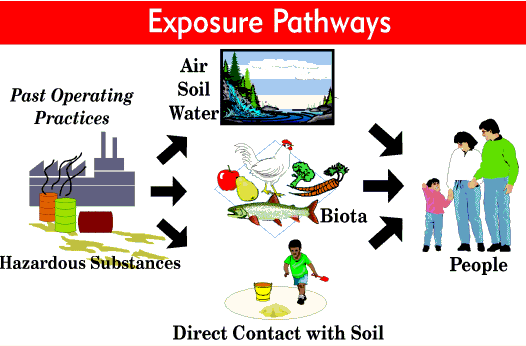Spring Valley,
Washington, DC
| Semiannual
Newsletter No. 1 |
February, 2002 |
|
The Agency for Toxic Substances and Disease Registry is pleased
to provide this community newsletter to the residents of the Spring Valley
community. This newsletter is the first in a series to be issued every
6 months. It is intended to provide local residents with information on
ATSDR and its activities related to the Spring Valley site.We value and
welcome the opinions and comments of the Spring Valley residents. We remain
committed to doing all that we can to provide you with a scientifically
sound health investigation and with other actions that address your health
concerns.
Sincerely,
Robert C. Williams, PE, DEE
Assistant Surgeon General
Director, Division of Health Assessment and Consultation / ATSDR |
What is ATSDR?
The Agency for Toxic Substances and Disease Registry (ATSDR) is a federal public
health agency based in Atlanta, Georgia. Created by the Comprehensive Environmental
Response, Compensation, and Liability Act of 1980 (known as Superfund legislation),
ATSDR's mission is to serve the public by using the best science, taking responsive
public health actions, and providing trusted health information to prevent harmful
exposures and disease related to toxic substances.
Why is ATSDR involved at Spring Valley?
In March 2001, ATSDR received
a petition for a full and complete environmental health assessment of the American
University Experiment Station/Spring Valley site. In addition, in June 2001, the
District of Columbia Department of Health asked ATSDR to evaluate whether some
residents of Spring Valley had been exposed to arsenic.
How will ATSDR evaluate health concerns at Spring Valley?
ATSDR will conduct an exposure investigation for arsenic and prepare a public
health consultation on the potential for adverse human health effects from exposure
to hazardous substances at Spring Valley.
What is an exposure investigation?
An exposure investigation collects information on specific human exposures
to hazardous substances in the environment. On the basis of past environmental
sampling at the Spring Valley site, ATSDR has determined that certain residents
may be more at risk for arsenic exposure than other residents. ATSDR is proposing
biomedical testing for those residents who may be at a higher risk.
How will ATSDR find out if a person has been exposed to arsenic?
Whether a person has been exposed to arsenic may be determined through laboratory
analysis of samples of that person's hair or urine. Urine samples are useful
only in detecting recent exposure (within a couple of days of the sample collection).
Hair samples, under certain conditions, may detect exposure that occurred weeks
or months earlier. In response to community concerns about past exposure, ATSDR
may look at both hair and urine samples to get a more complete picture of arsenic
exposure.
What is a public health consultation?
A public health consultation is conducted to evaluate specific public health
issues related to real or potential human exposure to hazardous substances.
Focusing on specific issues allows ATSDR to respond quickly to a need for health
information regarding possible exposure to hazardous substances. A public health
consultation document may include recommendations for actions to protect public
health.
What is an exposure pathway?
Exposure pathway is a term used to describe the route-or pathway-from the source
of a chemical to the point where a person may come into contact with the chemical.
A person can not be affected by a chemical unless the person comes into contact
with the chemical. A complete exposure pathway includes all the links between
a chemical source and the person exposed. A complete exposure pathway must have
each of the following five elements.
- a chemical source
- an environmental medium in which the chemical moves
(such as air, water, or food)
- a point of exposure (a place where a person could contact the chemical)
- a route of exposure
- a person or persons who could be exposed
What is a route of exposure?
A route of exposure describes how a chemical contacts or enters a person's
body. The following are possible routes of exposure.
- Ingestion-eating or drinking something with a chemical in or on it
- Inhalation-breathing air that has a chemical in it
- Skin/Dermal Contact-touching something that has a chemical on or in it
Will I get sick if I have been exposed?
Most people who are exposed to a chemical do not get sick. A combination of
factors determine whether you will get sick from an exposure. These factors
are
- Duration-how long the exposure lasted
- Frequency-how often the exposure occurred
- Concentration-the concentration level of the chemical at the point of exposure
- Population-the person or persons exposed
- Route-the way the person was exposed (for example, by breathing, eating, or touching)
What if I have a concern that ATSDR has not addressed?
ATSDR is in the process of determining the community's needs in regard to health
education and community involvement materials. We are also gathering general
concerns regarding the Spring Valley site. Please forward any concerns or comments
to Loretta Bush, ATSDR, 1600 Clifton Road, NE, Atlanta, GA 30333 or by e-mail
at lsbush@cdc.gov.
For additional information, please contact any of the following ATSDR representatives.
- Laura Frazier, Environmental Health Scientist
Lead Health Assessor for Spring Valley
toll-free: 1-888-422-8737
e-mail: lfrazier@cdc.gov
- Loretta Bush, Health Communications Specialist
Community Involvement Branch
toll-free: 1-888-422-8737
e-mail: lsbush@cdc.gov
- Robert H. Johnson, Medical Officer
Exposure Investigation Branch
toll-free: 1-888-422-8737
e-mail: rhjohnson@cdc.gov
- Mark Miller, Health Education Specialist
Health Education Branch
toll-free: 1-888-422-8737
e-mail: mdmiller@cdc.gov
- Dana Abouelnasr, Environmental Health Scientist
Office of Federal Programs
toll-free: 1-888-422-8737
e-mail: dabouelnasr@cdc.gov
- Tom Stukas, Regional Representative
ATSDR's Philadelphia Office
215-814-3142
email: stukas.tom@epamail.epa.gov
Healthy People in a Healthy Environment
This page last updated on March 12, 2002
Webmaster ATSDR-OpeaMail@cdc.gov
ATSDR
Home | Search | Index
| Glossary | Contact
Us
About
ATSDR | News Archive |
ToxFAQs | Public Health Assessments
Privacy
Policy | External Links Disclaimer
| Accessibility
U.S.
Department of Health and Human Services


